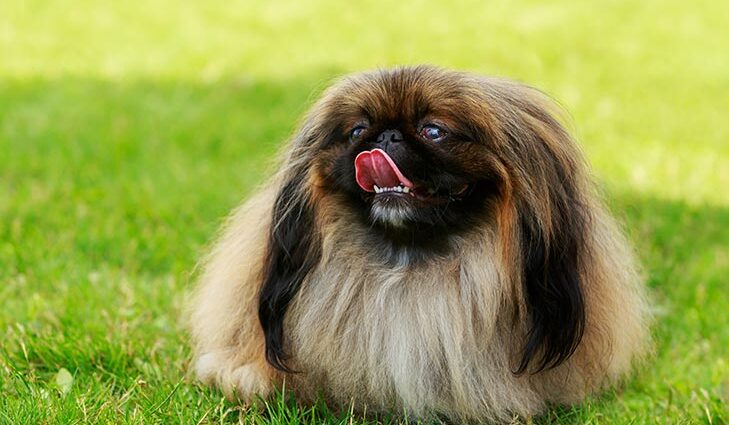Contents
Pekingese
Physical Characteristics
The Pekingese is a small dog. Males do not exceed 5 kg and females peak at 5,4 kg. They have black pigmented nose, lips and eyelid edges. The nose is short, but not too much. The coat is relatively long and straight, with a thick, soft undercoat. All coat colors are allowed with the exception of albino and liver color.
The Pekingese is classified by the Fédération Cynologiques Internationale as pleasure and companion dogs in the section of Japanese and Pekingese spaniels. (1)
Origins and history
The origins of the Pekingese are lost in Ancient China, but studies have found mentions of a similar dog up to 200 BC. It is likely that the ancestors of the Pekingese were brought to China by Muslim merchants who brought them back from Malta. In Chinese mythology, Pekingese originated from the cross between a lion and a marmoset. It is this aspect of the lion that breeders have sought to propagate in the breed. In the nineteenth century, the Chinese emperors had a passion for this little dog and owning it had become difficult. It was only in 1860 with the looting of the Imperial Summer Palace in Beijing by the British and the French that the first specimens were imported to Europe.
Character and behavior
The Pekingese is not fearful or even aggressive, but has a distant and fearless character. He possesses royal dignity and great intelligence. They are also very affectionate and therefore are good companions for the family. However, it retains a stubborn character and are sometimes difficult to domesticate.
Frequent pathologies and illnesses of Pekingese
The Pekingese is a very healthy dog, and according to the UK Kennel Club’s 2014 Purebred Dog Health Survey, around three-quarters of the animals studied were unaffected by a condition. The primary causes of death were old age and brain tumors. (3)
Like other purebred dogs, they are prone to developing hereditary diseases. These include congenital elbow dislocation, distichiasis, testicular ectopia and inguinal and umbilical hernias. (3-5)
Congenital dislocation of the elbow
Congenital elbow dislocation is a relatively rare condition. It is characterized by displacement of the bones of the elbow joint, radius and ulna, accompanied by tearing of the ligaments.
As early as four to six weeks, the dog develops lameness and deformity of the elbow. X-ray examination confirms the diagnosis.
Surgical treatment should be started as soon as possible and consists of returning the joint to its natural position before temporarily immobilizing it in this position.
Distichiasis
Distichiasis is characterized by an extra row of cilia at the site of the meibomian glands, which produce protective fluid for the eye. Depending on the number, texture and friction on the eye this additional row may be of no consequence or it may also cause keratitis, conjunctivitis, or corneal ulcers.
The slit lamp makes it possible to visualize the additional row of eyelashes and to make a formal diagnosis. The veterinarian should then examine the corneal involvement.
The risk of blindness is low and the treatment most often consists of a simple waxing of the supernumerary eyelashes.
Distichiasis should not be confused with trichiasis, which can also affect the Pekingese
In the case of trichiasis, the excess eyelashes come out of the same hair follicle and their presence causes the eyelashes to deviate towards the cornea. The diagnostic methods and treatment are the same as for distichiasis. (4-5)
Testicular ectopy
Testicular ectopy is a defect in the positioning of one or both testicles in the scrotum. These should be brought down around the age of 10 weeks. Diagnosis is made mainly by palpation. The treatment can be hormonal to stimulate the descent of the testicle, or surgical to remove the testicle. If ectopia is not associated with the development of a tumor of the testis, it is not a serious pathology.
Umbilical or inguinal hernia
A hernia is characterized by the exit of internal organs outside their natural cavity. The umbilical hernia is a congenital anomaly which represents 2% of the hernias in the dog while the inguinal hernia represents 0.4% of the cases and mainly affects the females.
In an umbilical hernia, the viscera protrude under the skin in the abdomen. In the case of inguinal hernia the abdominal organs protrude into the inguinal canal.
Umbilical hernia appears in puppies up to 5 weeks old and can resolve spontaneously if the hole is small. Most often, the hernia evolves into a hernial lipoma, that is to say a mass of fat, without risk of complications. In this case, the inconvenience is mainly aesthetic. For a larger hernia, the prognosis will be more reserved. Palpation is sufficient for the diagnosis and makes it possible to assess the size of the latter and the organs that have protruded.
The inguinal hernia can mainly cause complications during gestation and is visualized by x-ray or ultrasound
Surgery closes the opening and replaces the internal organs.
See the pathologies common to all dog breeds. |
Living conditions and advice
Due to the long undercoat, Pekingese require at least one brushing session per week.
Pekingese can tolerate children, but if you’re looking for a children’s playmate, you’ll have to look elsewhere.
With its small size and low need for exercise, this dog is ideal for apartment living. He will still enjoy walks with his master.










